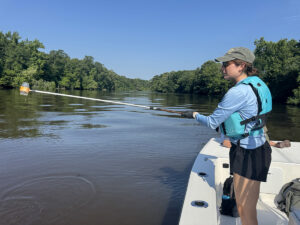News
PFAS in the Tar-Pamlico and Neuse River Basins
Environmental, Neuse River Watershed, Sound Rivers, Tar-Pamlico Watershed, Water Quality
Posted on September 4th, 2023
What are PFAS?
Perfluorinated alkyl substances, or PFAS, are a family of man-made chemicals that have been widely used in manufacturing and consumer products — like nonstick cookware and water resistant clothing — since at least the 1950s. The spotlight on PFAS in North Carolina arose through GenX and Chemours-related compounds, however, the issue of PFAS is larger than just one compound or one company. There are more than 10,000 types of PFAS, all of which are biopersistent, meaning they remain in organisms indefinitely without breaking down, and are bioaccumulative, meaning that over time, they build up in ever increasing amounts in people, wildlife, aquatic life, and the environment. Because these chemicals take thousands of years to break down and accumulate in people, wildlife, aquatic life, and the environment, they are also known as “forever chemicals.” In an October 2022 report released by Waterkeeper Alliance, surface water samples were collected from 114 waterways in 34 states and the District of Columbia (D.C.) by riverkeepers for analysis for PFAS. 83% of the waters tested across the country were found to be contaminated by dangerous PFAS chemicals. What this means–dangerous PFAS pollution is widespread in surface waters across the country.

PFAS in the Tar-Pamlico and Neuse
To date, little is known about levels of PFAS in the Tar-Pamlico and Neuse rivers’ watersheds. In order to determine if PFAS are a widespread issue and present at concerning levels in our watersheds, we have begun sampling of surface waters through projects with Waterkeeper Alliance and Waterkeepers Carolina, using Cyclopure water testing kits.
Related News

Neuse fish kill expected to extend beyond holiday weekend
July 3rd 2025

Swim Guide fails prompt Maple Cypress investigation
July 3rd 2025

Riverkeeper, town partners root out source of Smithfield sediment pollution
July 3rd 2025

Trash trap No. 12 approved for Smithfield
July 3rd 2025

Sunset River Paddle fundraiser boosts Water Quality Fund
July 3rd 2025

Riverkeepers host quarterly Water Watch meeting
July 3rd 2025

Public hearing will determine the fate of many NC wetlands
June 26th 2025

Clayton gets first official trash-trap cleanout
June 25th 2025

